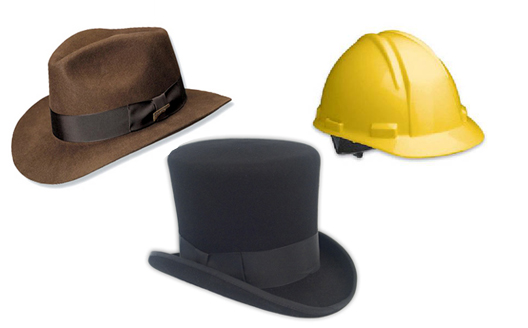3 Hats that a User Experience Designer Wears

 In my last post, I defined a few
site types to aim for when designing, in order to give designers a
sense of the roles they might need to play when running a user
experience design (UXD) project. Generally, regardless of the site
you are designing however, as a UX designer you will have to adapt
and wear different hats depending on the project.
In my last post, I defined a few
site types to aim for when designing, in order to give designers a
sense of the roles they might need to play when running a user
experience design (UXD) project. Generally, regardless of the site
you are designing however, as a UX designer you will have to adapt
and wear different hats depending on the project.
Here I will describe the three primary roles you’ll find yourself in: 1) User Researcher, 2) Information Architect and 3) Interaction Designer.
1- User Researcher
As a researcher, you will be essentially working to understand a site’s users, conducting user interviews, surveys, and a/b tests (in which you demo two different interfaces to different users), in order to provide stakeholders with insights about what users really want.
Personally, this is one of my favorite hats to wear, because in this role you gain detailed insights into what the users are and are not doing; it gives you a big chance to experiment with new elements on the site.
I should note that whenever I mention the word ‘insight,’ stakeholders immediately want to give me access to their analytics tools. You should know that these are not the insights you are looking for. Analytics can help, but what is required is much more in-depth than simply understanding how many users access your site and from where; good research involves conversations and testing.
In general, the research element of user experience design is not well understood by most companies; they may view it as a needless extra step or even a hurdle, especially since it takes awhile. It's really up to you as a UX geek to evangelize it.
With regards to the site types I laid out in my last post, user research is most critical to brand building websites, because it will demonstrate how effective the visual design is in communicating the identity and branding message of a company.
Research is also useful for content aggregation websites, as it shows how users handle information, and how they search and share.
2- Information Architect
Site map? I‘d prefer to call it a structure. Either way, creating user-friendly navigation and categorization are essential for building a structure that users understand. For example, if you have information about bananas, it goes under the category of fruits not cars. This may be an extreme example, but in future posts I will dive into the details of how to structure your site. Not only you will be responsible for creating friendly navigation and categorization, but also for the naming conventions used to describe these categories and special actions.
You will have to tedious job of categorizing the information and labeling it; some knowledge of "library science" will help. And last but not least, you should not confuse this role with that of the “Content Strategist,” although they do intertwine and you will ultimately work together to optimize the way that content is presented.
Of the sites I described in my last post, this role will help the most with Content Aggregation sites, for which a solid and balanced but flexible structure is imperative. It will also help with Task Oriented sites, which necessitate action categorization and naming conventions.
3- Interaction Designer
As an interaction designer, you will have to define the task flow of an application, in other words, the process that the user will have to take to execute a certain task or action. You will focus on how user behavior affects the flow, and how to put it make it as universal as possible for so that a variety of users will find it intuitive.
Before starting any interaction design, you will need to gather as many details as possible from the stakeholders, especially the product manager if relevant, about the specifications and functionalities of the app or site. This is crucial.
You will have to adopt this role when building Task-Oriented sites, especially, since they are all about tasks! User process flows and wireframes are your new best friends.
This role will also be needed for Content Aggregation sites,
where most of your work will go towards creating a good backend
content management system, and also on the front end building a
good search engine.
These are not the only roles you might need to play during a project. You might end up doing some front end development, some content strategy, and even some copywriting… being a user experience designer always involves a multidisciplinary approach.
Yet, it’s important to focus. If you are familiar with the saying “jack of all trades, master of none,” in this case it really should be “jack of all trades and master of ONE.” Pick one area and focus on it while cultivating broad knowledge in the rest.
In the next post, I will address how to approach the project by setting goals and reading, reading again and reading some more.


